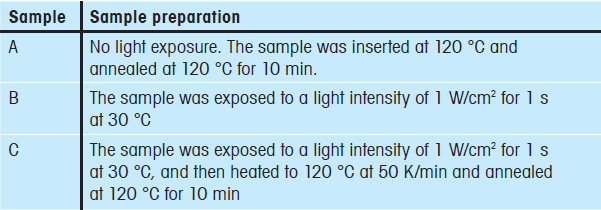Photocalorimetric Simulation of the Light Curing of Adhesives
 Figure 1. Access arm for moving the read/write head over the surface of a disk in a hard disk storage device. A small sample of about 0.4 mg was cut out from the position shown and analyzed by DSC.
Figure 1. Access arm for moving the read/write head over the surface of a disk in a hard disk storage device. A small sample of about 0.4 mg was cut out from the position shown and analyzed by DSC. Table 1. Overview of the different methods used to prepare samples.
Table 1. Overview of the different methods used to prepare samples.Introduction
Modern electronic components consist of a multitude of miniaturized parts and connections. In production processes, these have to be fixed accurately in place. One way to do this is to use light-curing adhesives that cure within a few seconds. The technique has several important advantages: the components are not subjected to thermal or mechanical stresses and the actual fixing process takes place very quickly.
This article describes how we investigated the curing behavior of a technical adhesive used in the manufacture of access arms for the read/write heads of hard disk storage devices. The approach chosen was to simulate the production methods in a DSC-photocalorimeter system, and to analyze the cured samples with respect to their postcuring behavior. The results were then compared with measurements of real samples taken from different access arms.
Figure 1 shows a typical access arm. The comparison measurements were performed using small samples (approx. 0.4 mg) cut out from the region marked “sample”.
Experimental details
The present study was performed using a METTLER TOLEDO DSC822e equipped with an IntraCooler and the photocalorimeter accessory. A Hamamatsu “Lightning Cure 200” with a xenon-mercury lamp was used as light source. The design of the system and the general measurement procedure have been described...
Download the full text of this article below.
Conclusions
The measurements show that the process as it is currently operated results in a degree of cure or cross-linking of 90%. The annealing process accelerates the outgassing of the adhesive, which above all influences the width of the glass transition. In contrast, annealing has practically no influence on the degree of cross-linking. This is confirmed by a kinetic analysis of isothermal curing using model free kinetics (MFK). The results obtained in the laboratory for the curing behavior of the adhesive agree well with measurements performed on access arms that originated directly from the production process.
DSC-photocalorimetry can therefore be recommended as a straightforward and economical method to control, simulate, understand, and if necessary optimize technologically demanding processes.
Photocalorimetric Simulation of the Light Curing of Adhesives | Thermal Analysis Application No. UC233 | Application published in METTLER TOLEDO Thermal Analysis UserCom 23
Introduction
Modern electronic components consist of a multitude of miniaturized parts and connections. In production processes, these have to be fixed accurately in place. One way to do this is to use light-curing adhesives that cure within a few seconds. The technique has several important advantages: the components are not subjected to thermal or mechanical stresses and the actual fixing process takes place very quickly.
This article describes how we investigated the curing behavior of a technical adhesive used in the manufacture of access arms for the read/write heads of hard disk storage devices. The approach chosen was to simulate the production methods in a DSC-photocalorimeter system, and to analyze the cured samples with respect to their postcuring behavior. The results were then compared with measurements of real samples taken from different access arms.
Figure 1 shows a typical access arm. The comparison measurements were performed using small samples (approx. 0.4 mg) cut out from the region marked “sample”.
Figure 1. Access arm for moving the read/write head over the surface of a disk in a hard disk storage device. A small sample of about 0.4 mg was cut out from the position shown and analyzed by DSC.
Table 1. Overview of the different methods used to prepare samples.
Experimental Details
The present study was performed using a METTLER TOLEDO DSC822e equipped with an IntraCooler and the photocalorimeter accessory. A Hamamatsu “Lightning Cure 200” with a xenon-mercury lamp was used as light source. The design of the system and the general measurement procedure have been described...
Download the full text of this article below.
Conclusions
The measurements show that the process as it is currently operated results in a degree of cure or cross-linking of 90%. The annealing process accelerates the outgassing of the adhesive, which above all influences the width of the glass transition. In contrast, annealing has practically no influence on the degree of cross-linking. This is confirmed by a kinetic analysis of isothermal curing using model free kinetics (MFK). The results obtained in the laboratory for the curing behavior of the adhesive agree well with measurements performed on access arms that originated directly from the production process.
DSC-photocalorimetry can therefore be recommended as a straightforward and economical method to control, simulate, understand, and if necessary optimize technologically demanding processes.
Photocalorimetric Simulation of the Light Curing of Adhesives | Thermal Analysis Application No. UC233 | Application published in METTLER TOLEDO Thermal Analysis UserCom 23